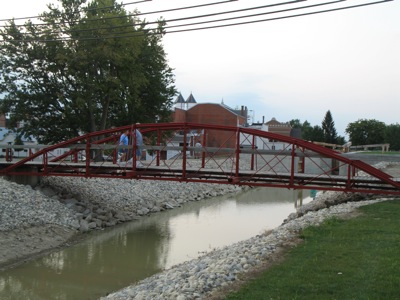Wednesday, August 15th, 2007
Red-faced over bridge in Bremen
By Margie Wuebker

Photo by Margie Wuebker/The Daily Standard
A pair of New Bremen walkers cross Morrison Bridge spanning the Miami-Erie Canal on Tuesday night. Resident Joe Eilerman expressed outrage that village officials painted the landmark bowstring bridge red in recent weeks. The color will be going back to black as a result of village council action.
NEW BREMEN - The recent painting of Morrison Bridge, the oldest bowstring girder bridge in the state, has one local resident seeing red in more ways than one.
Joe Eilerman voiced his opposition to the village having painted the bridge red and asked Village Administrator Wayne York why members of the New Bremen Bridge Committee had not been contacted regarding color selection.
York explained preparation of the cast iron bridge off South Washington Street had been ongoing with wire brushing and priming. He hurriedly polled elected officials as well as the Community Improvement Corporation and the planning commission after several people commented the reddish primer color would look nice.
Of the 19 residents responding to his query, 10 favored red, five wanted the 57-foot span repainted black and four expressed no preference. The decision was made within 48 hours so work could proceed as the Lock One Restoration Project nears completion.
"I'm trying to determine the logic here," Eilerman said. "Did you look at the name of the organization that donated the bridge?"
York quickly responded "No, I looked at the bridge." He added the red color matched nearby playground equipment as well as metal framework at The Crown Pavilion.
Eilerman explained committee members initially sought input from David Simmons, a state preservation officer at the time, regarding appropriate color choices. Based on his advice, the committee painted the bridge black prior to its 1984 installation over the Miami-Erie Canal.
"This is equivalent to painting the Golden Gate Bridge silver or a Duesenberg metal flake purple," he said with obvious distaste. "Red is not appropriate for the oldest bowstring bridge in the state; you might as well have painted it camouflage."
Councilor Delores Stienecker, a member of the New Bremen Historic Association, noted historical accuracy is important. Association members faced that detail during recent interior work at the museum.
They painted the walls white - the color of paint available in bygone times. Had the choice been blue, they would have faced crushing blueberries to obtain the proper hue in order to maintain historical integrity.
"Wayne had an idea and put the color choice to a vote," Mayor Jeff Pape said in the village administrator's defense. "Unfortunately, the vote favored red."
Councilor John Schwartz noted plans to drain the canal in order to fix a north wicket gate problem at nearby Lock One would provide an ideal opportunity to repaint the bridge black. Fellow councilors nodded in agreement.
While no official action was taken regarding color designation 23 years ago, councilors quickly rectified the situation by unanimously passing emergency legislation specifying the bridge will be repainted black and remain black henceforth.
Eilerman also announced his intention to donate a wealth of bridge information to the museum with Stienecker accepting on behalf of the association.
The bridge committee purchased the bridge from the Auglaize County Commissioners in 1984 with a bid of $650 - more than twice the estimated market value of the cast iron used in its construction.
Community residents and businesses rallied behind the project donating money and materials to install the bridge in the canal area behind the local library. Eilerman and fellow committee member Bill Woehrmyer signed a commemorative document bequeathing the structure to the village in hopes it would serve as a lasting example of the community's pride in preserving a rich heritage. The framed document remains on display at the village administration building.
Eilerman's research indicates the bridge was constructed in 1864 by David H. Morrison, founder of Columbia Bridge Works in Dayton. It was originally part of the Blackhoof Bridge in Wapakoneta before being moved to Moulton Angle Road, north of New Knoxville, in 1894. It remained there until replacement in 1984.

